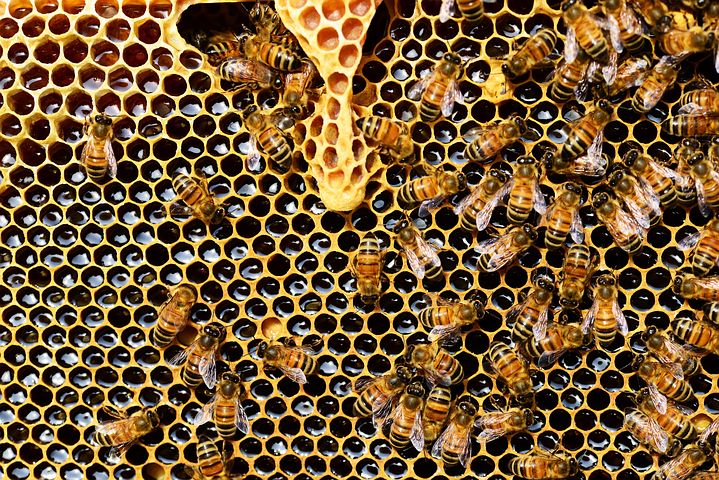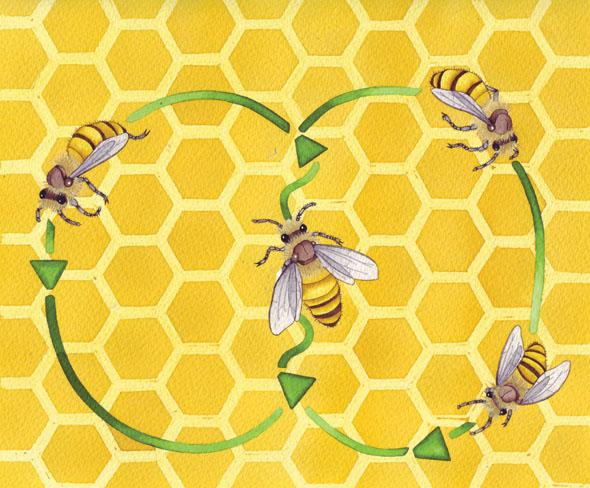
On May 20th, which is World Bee Day, it’s even more important than any other day to recognize these very industrious, intelligent, efficient little insects. They are singularly the most important pollinator on Earth. Along with the others included in this classification, like butterflies and bats, they are responsible for pollinating at least 35% of the crops we humans eat. If we look specifically at fruits and seeds, this percentage increases dramatically, to 75%. They really are incredibly important for biodiversity and continued life on this planet. Whether or not you believe the quote regarding humans becoming extinct within 4 years of bee extinction, there can be little argument over their vital role in our lives. Nor can there be argument over their dwindling numbers. So we must start rigorously protecting our bee populations. And this isn’t actually difficult:

- Stop using pesticides, herbicides and fungicides (especially neonicotinoid varieties) in your garden;
- plant bright colored flowering plants and trees, like roses, lavender, crocuses, rosemary, ox-eye daisy and apple trees;
- in particularly hot weather leave water in a small bowl with cork or small rocks in it for bees to sit on while they drink;
- and don’t weed your garden, as things such as dandelions are very good for bees (plus this gives you more free time on the weekend too!).

We’ve decided to pay homage specifically to the honey bee, on this day of celebration in bee’s honor, as we’ve chosen the honey bee to represent us. So let’s take a look at some of the most interesting, and possibly little known, facts about them.
Although there are 20,000 species of bees, there are only ten types which produce honey (yes, all various species of honey bee…thankfully science doesn’t make everything complicated!).
There are 3 sub-types of honey bee in the colony: Drone, Worker and Queen. You probably knew this already – but did you know that the drones are the only males in the colony? There are only several hundred of them in each colony and they literally only have one job – to mate with the Queen. They can’t make wax, collect nectar or pollen (as they don’t have a probiscus, or tongue), and they don’t have a sting. The fastest of the drones will catch and mate with the new Queen as soon as she emerges from the nest. Then they die. Immediately. They will be dead before they fall to the ground. Isn’t that crazy? Those who aren’t lucky enough to mate with the Queen will return to the nest…but during the winter, when food stores are needed for the growing lavae, they get kicked out. Even despite this, their lifespan is the shortest of the honey bees, being only a few weeks.

Another little known fact is that the worker bees are all female. There are tens of thousands in each colony, making up 99% of the population, and they are the only ones you will generally see outside of a nest. They do pretty much everything: build and protect the nest; forage for pollen, nectar and water; clean the nest; remove the moisture from the nectar, which turns it to honey (by hovering over the cell with the nectar in and beating her wings furiously); and nurse the young. All of this in their short lifespan of about 45 days! Throughout this life, she will actually take on different jobs, according to her age.
There is only one Queen in every colony. She mates with up to 15 drones over a 3 day period in spring and then lays up to 1,500 eggs per day during spring and summer. She can live between 4 and 7 years, which is an extremely long time from a bee’s perspective. This may be attributed to the fact that the one lava chosen to be Queen is fed royal jelly – the rest of the lavae only get pollen and nectar. Royal Jelly, has therefore become a very popular health and wellbeing product for us humans, as it reportedly has anti-aging and general healing properties (scientific data is somewhat lacking, but anecdotal reports are in abundance).

Honey bees beat their wings about 200 times/second when flying, which is what creates the distinctive buzzing sound. But they can also vibrate their wings, and when they combine this with carefully performed movements, they are doing their ‘waggle dance’. This is the way they communicate the exact location of high quality (and volumes) of pollen, nectar or water supplies. Most waggle dances last between 1 and 1000 waggles, and have the bee ‘dance’ in a figure-8 pattern: fluttering wings whilst in the loop sections, with a straight walk (‘waggle run’) down the middle of the loops. She also allows her peers to smell the odour of the flowers she has harvested from. This is a very complex, and very effective communication method!
One last thing which you may not know is that where a bee colony lives is called a nest. It is only called a ‘hive’ when it’s a man-made home for them.
So given some of the above information, it’s no coincidence that we have chosen the honey bee as our muse. Nor is it a coincidence that we are “swrm”. Honey bees are extremely social and community minded, living in large colonies; they communicate in a very effective manner, working together at all times; they protect the colony at any cost, sometimes making individual sacrifices for the greater good; they are absolutely necessary for the survival of very many of our food sources; and they are known as a superorganism, based in part on their efficient living, making their entire colony operate as though it were one organism instead of tens of thousands (read more on this from our previous article). We are working towards a more efficient planet Earth, so the honey bee is our perfect mascot! We invite you to join our swarm, and be a part of this important community of environmentally minded sustainability warriors, trying to make this planet inhabitable and appreciated by humans for as long as we can. And while on this path, let’s not forget to save the bees!



